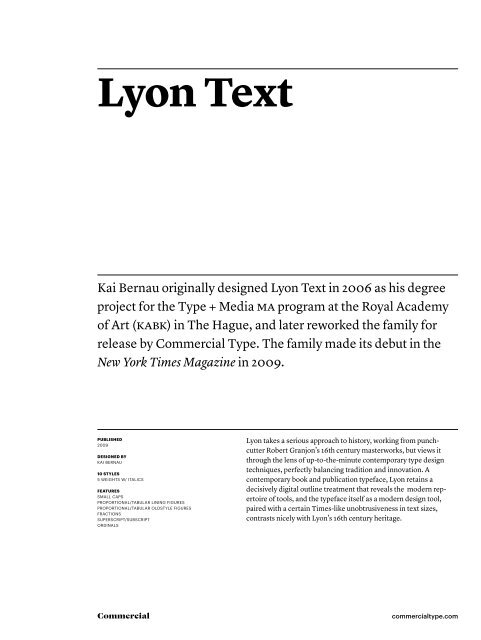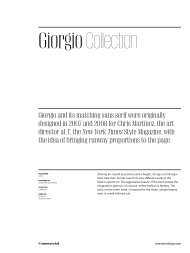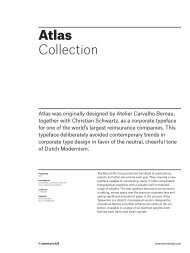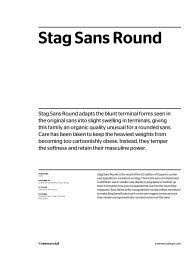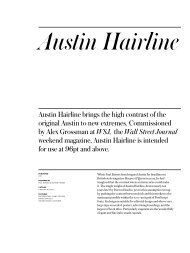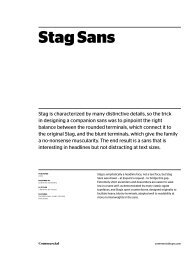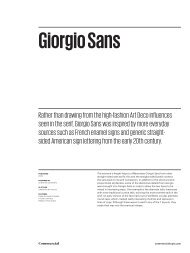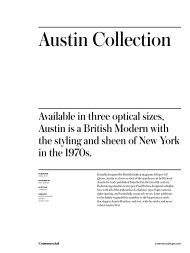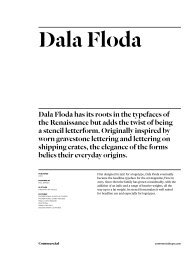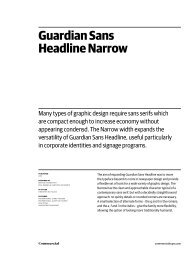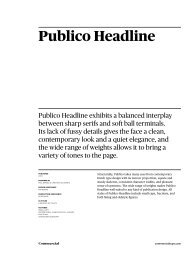Lyon Text family - Commercial Type
Lyon Text family - Commercial Type
Lyon Text family - Commercial Type
Create successful ePaper yourself
Turn your PDF publications into a flip-book with our unique Google optimized e-Paper software.
<strong>Lyon</strong> <strong>Text</strong><br />
Kai Bernau originally designed <strong>Lyon</strong> <strong>Text</strong> in 2006 as his degree<br />
project for the <strong>Type</strong> + Media MA program at the Royal Academy<br />
of Art (KABK) in The Hague, and later reworked the <strong>family</strong> for<br />
release by <strong>Commercial</strong> <strong>Type</strong>. The <strong>family</strong> made its debut in the<br />
New York Times Magazine in 2009.<br />
PUBLISHED<br />
2009<br />
DESIGNED BY<br />
KAI BERNAU<br />
10 STYLES<br />
5 WEIGHTS W/ ITALICS<br />
FEATURES<br />
SMALL CAPS<br />
PROPORTIONAL/TABULAR LINING FIGURES<br />
PROPORTIONAL/TABULAR OLDSTYLE FIGURES<br />
FRACTIONS<br />
SUPERSCRIPT/SUBSCRIPT<br />
ORDINALS<br />
<strong>Lyon</strong> takes a serious approach to history, working from punchcutter<br />
Robert Granjon’s 16th century masterworks, but views it<br />
through the lens of up-to-the-minute contemporary type design<br />
techniques, perfectly balancing tradition and innovation. A<br />
contemporary book and publication typeface, <strong>Lyon</strong> retains a<br />
decisively digital outline treatment that reveals the modern repertoire<br />
of tools, and the typeface itself as a modern design tool,<br />
paired with a certain Times-like unobtrusiveness in text sizes,<br />
contrasts nicely with <strong>Lyon</strong>’s 16th century heritage.<br />
<strong>Commercial</strong><br />
commercialtype.com
<strong>Lyon</strong> <strong>Text</strong> 2 of 17<br />
<strong>Lyon</strong> <strong>Text</strong> Regular<br />
<strong>Lyon</strong> <strong>Text</strong> Regular Italic<br />
<strong>Lyon</strong> <strong>Text</strong> Regular No. 2<br />
<strong>Lyon</strong> <strong>Text</strong> Regular No. 2 Italic<br />
<strong>Lyon</strong> <strong>Text</strong> Semibold<br />
<strong>Lyon</strong> <strong>Text</strong> Semibold Italic<br />
<strong>Lyon</strong> <strong>Text</strong> Bold<br />
<strong>Lyon</strong> <strong>Text</strong> Bold Italic<br />
<strong>Lyon</strong> <strong>Text</strong> Black<br />
<strong>Lyon</strong> <strong>Text</strong> Black Italic<br />
Society of the Spectacle<br />
Society of the Spectacle<br />
REGULAR & REGULAR ITALIC, 16 PT<br />
Society of the Spectacle<br />
Society of the Spectacle<br />
REGULAR NO. 2 & REGULAR NO. 2 ITALIC, 16 PT<br />
Different printing methods – and different taste – make for<br />
disparate requirements in the overall color of a block of text,<br />
so Kai Bernau has included two different Regular weights in<br />
the <strong>Lyon</strong> <strong>Text</strong> <strong>family</strong>. <strong>Lyon</strong> <strong>Text</strong> Regular is a bit lighter, with a<br />
quieter, more airy feel on coated paper. Conversely, it prevents<br />
blocks of text from looking too dark when printed on uncoated<br />
paper, where type has a tendency to gain weight. <strong>Lyon</strong> <strong>Text</strong><br />
Regular No. 2 is noticeably darker, giving it a more forceful<br />
presence on coated paper, and making it work well for smaller<br />
sizes and reversing type out of a dark background.<br />
<strong>Commercial</strong><br />
commercialtype.com
<strong>Lyon</strong> <strong>Text</strong> 3 of 17<br />
THIS GREAT INCREASE IN THE QUANTITY OF PRODUCTIONS<br />
The social appropriation of time and the production of man by human<br />
Pittacus of Mytilene, son of Hyrradius, died in 568 BCE, he challenged<br />
IT’S A CONSEQUENCE OF THE DIVISION OF LABOUR, THEREBY<br />
Secondly, The advantage which is gained by saving the time commonly lost<br />
LYON TEXT REGULAR, REGULAR ITALIC, 14 PT [ALTERNATE h, v, w]<br />
THE DISAPPEARANCE OF THE PARTICULAR CONDITIONS OF<br />
The constant tendency toward the monopolization of the productive<br />
A város alatt némán kanyarodtak le a Hodrics felé vezető útra. A hold<br />
FU UN TERRORE E NELLO STESSO TEMPO UNA SPERANZA CHE<br />
Spain had to declare four state bankruptcies in 1557, 1560, 1575 and 1596<br />
LYON TEXT REGULAR NO. 2, REGULAR NO. 2 ITALIC, 14 PT<br />
THE FIRST SOVEREIGN NATION TO ISSUE A DECLARATION<br />
There were earlier precedents, but the 1976 novel is most relevant<br />
In 1541, the Amazon River is discovered by Francisco de Orellana<br />
THE OWNERS OF HISTORY HAVE GIVEN TIME A DIRECTION<br />
Ogni giorno egli spendeva qualche tempo a guardarli moversi, ed era<br />
LYON TEXT SEMIBOLD, SEMIBOLD ITALIC, 14 PT<br />
OBSERVERS REPORT A REMARKABLE SURGE IN MARKET<br />
To say nothing of such complicated machines as the ship of the<br />
Every workman has a great quantity of his own work to dispose<br />
IN 1978, THE FIRST COMPUTER BULLETIN BOARD SYSTEM<br />
It is the great multiplication of the productions of all the different<br />
LYON TEXT BOLD, BOLD ITALIC, 14 PT<br />
LE COÛT DE CES ÉQUIPEMENTS ÉTAIT TRÈS ÉLEVÉ CAR<br />
Tato zahrádka byla jim zároveň pravým rejdištěm, na němžto<br />
In 1579, the Union of Utrecht unifies the northern Netherlands<br />
FROBEN ALSO EMPLOYED HANS HOLBEIN THE YOUNGER<br />
He olivat ystäviä ystävyydessä, joka oli läheisempää kuin veljeys<br />
LYON TEXT BLACK, BLACK ITALIC, 14 PT<br />
<strong>Commercial</strong><br />
commercialtype.com
<strong>Lyon</strong> <strong>Text</strong> 4 of 17<br />
LYON TEXT REGULAR, 14 PT<br />
REGULAR SMALL CAPS<br />
REGULAR<br />
SEMIBOLD<br />
PROPORTIONAL<br />
OLDSTYLE FIGURES<br />
REGULAR ITALIC<br />
BOLD<br />
PROPORTIONAL<br />
LINING FIGURES<br />
PROPORTIONAL<br />
OLDSTYLE FIGURES<br />
REGULAR ITALIC<br />
THE SPANISH WAR, which began in 1739, and the<br />
French war which soon followed it, occasioned a<br />
further increase of the debt, which, on the 31st of<br />
December 1748, after the war had been concluded<br />
by the treaty of Aix-la-Chapelle, amounted to<br />
£78,293,313. The most profound peace, of 17 years<br />
continuance, had taken no more than £8,328,354,17<br />
from it. A war, of less than nine years continuance,<br />
added £31,338,689 to it. (Refer to Postlethwaite’s<br />
History of the Public Revenue.) During the administration<br />
of Mr. Pelham, the interest of the public<br />
debt was reduced to 3%; the sinking fund was<br />
increased, and some part of the public debt was<br />
paid off. In 1755, before the breaking out of the late<br />
war, the funded debt of Great Britain amounted<br />
to £72,289,675. On the 5th of January 1763, at the<br />
conclusion of the peace, the funded debt amounted<br />
debt to £122,603,336. The unfunded debt has been<br />
stated at £13,927,589. But the expense occasioned<br />
by the war did not end with the conclusion of the<br />
peace; so that, on the 5th of January 1764, the funded<br />
debt was increased (partly by a new loan, and<br />
partly by funding a part of the unfunded debt) to<br />
£129,586,789, there still remained (according to the<br />
very well informed author of Considerations on the<br />
Trade and Finances of Great Britain) an unfunded<br />
debt, which was brought to account in that and the<br />
following year, of 975,017. In 1764, therefore, the<br />
<strong>Commercial</strong><br />
commercialtype.com
<strong>Lyon</strong> <strong>Text</strong> 5 of 17<br />
LYON TEXT REGULAR NO. 2, 14 PT<br />
REGULAR NO. 2 SMALL CAPS<br />
REGULAR NO. 2<br />
BOLD<br />
PROPORTIONAL<br />
OLDSTYLE FIGURES<br />
REGULAR NO. 2 ITALIC<br />
BOLD<br />
PROPORTIONAL<br />
LINING FIGURES<br />
PROPORTIONAL<br />
OLDSTYLE FIGURES<br />
REGULAR NO. 2 ITALIC<br />
THE SPANISH WAR, which began in 1739, and the<br />
French war which soon followed it, occasioned<br />
a further increase of the debt, which, on the 31st<br />
of December 1748, after the war had been concluded<br />
by the treaty of Aix-la-Chapelle, amounted<br />
to £78,293,313. The most profound peace, of<br />
17 years continuance, had taken no more than<br />
£8,328,354,17 from it. A war, of less than nine years<br />
continuance, added £31,338,689 to it. (Refer to<br />
Postlethwaite’s History of the Public Revenue.) During<br />
the administration of Mr. Pelham, the interest<br />
of the public debt was reduced to 3%; the sinking<br />
fund was increased, and some part of the public<br />
debt was paid off. In 1755, before the breaking out<br />
of the late war, the funded debt of Great Britain<br />
amounted to £72,289,675. On the 5th of January<br />
1763, at the conclusion of the peace, the funded<br />
debt amounted debt to £122,603,336. The unfunded<br />
debt has been stated at £13,927,589. But<br />
the expense occasioned by the war did not end<br />
with the conclusion of the peace; so that, on the<br />
5th of January 1764, the funded debt was increased<br />
(partly by a new loan, and partly by funding a part<br />
of the unfunded debt) to £129,586,789, there still<br />
remained (according to the very well informed<br />
author of Considerations on the Trade and Finances<br />
of Great Britain) an unfunded debt, which was<br />
brought to account in that and the following year,<br />
<strong>Commercial</strong><br />
commercialtype.com
<strong>Lyon</strong> <strong>Text</strong> 6 of 17<br />
LYON TEXT REGULAR, REGULAR ITALIC, BOLD, 10/13 PT<br />
LYON TEXT REGULAR NO. 2, REGULAR NO. 2 ITALIC, BOLD, 10/13 PT<br />
THE OLD ENGLISH EAST INDIA COMPANY was<br />
established in 1600, by a charter from Queen<br />
Elizabeth. In the first twelve voyages which they<br />
fitted out for India, they appear to have traded<br />
as a regulated company, with separate stocks,<br />
though only in the general ships of the company.<br />
They united into a joint stock, in 1612. Their charter<br />
was exclusive, and, though not confirmed by<br />
act of parliament, was in those days supposed to<br />
convey a real exclusive privilege.<br />
Exclusive privilege of the royal charter<br />
For many years, the old English East India company<br />
were not much disturbed by interlopers.<br />
Their capital, which never exceeded £744,000,<br />
and of which £50 was a share, was not so exorbitant,<br />
nor their dealings so extensive, as to afford<br />
either a pretext for gross negligence and profusion,<br />
or a cover to gross malversation. Notwithstanding<br />
some extraordinary losses, occasioned<br />
partly by the malice of the Dutch East India<br />
company, and partly by other accidents, they<br />
carried on for many years a successful trade. But<br />
in process of time, when the principles of liberty<br />
were better understood, it became every day<br />
more and more doubtful, how far a royal charter,<br />
not confirmed by act of parliament, could convey<br />
an exclusive privilege. Upon this question the decisions<br />
of the courts of justice were not uniform,<br />
but varied with the authority of government, and<br />
the humours of the times. Interlopers multiplied<br />
upon them; and towards the end of the reign of<br />
Charles II, through the whole of that of James II,<br />
and during a part of that of William III, reduced<br />
them to great distress.<br />
Ramifications of the proposal of 1968<br />
In 1698, a proposal was made to parliament, of<br />
advancing two millions to government, at eight<br />
per cent. provided the subscribers were erected<br />
into a new East India company, with exclusive<br />
privileges. The old East India company offered<br />
seven hundred thousand pounds, nearly the<br />
THE OLD ENGLISH EAST INDIA COMPANY was<br />
established in 1600, by a charter from Queen<br />
Elizabeth. In the first twelve voyages which they<br />
fitted out for India, they appear to have traded<br />
as a regulated company, with separate stocks,<br />
though only in the general ships of the company.<br />
They united into a joint stock in 1612. Their<br />
charter was exclusive, and, though not confirmed<br />
by act of parliament, was in those days<br />
supposed to convey a real exclusive privilege.<br />
Exclusive privilege of the royal charter<br />
For many years, the old English East India company<br />
were not much disturbed by interlopers.<br />
Their capital, which never exceeded £744,000,<br />
and of which £50 was a share, was not so exorbitant,<br />
nor their dealings so extensive, as to afford<br />
either a pretext for gross negligence and profusion,<br />
or a cover to gross malversation. Notwithstanding<br />
some extraordinary losses, occasioned<br />
partly by the malice of the Dutch East India<br />
company, and partly by other accidents, they<br />
carried on for many years a successful trade. But<br />
in process of time, when the principles of liberty<br />
were better understood, it became every day<br />
more and more doubtful, how far a royal charter,<br />
not confirmed by act of parliament, could convey<br />
an exclusive privilege. Upon this question<br />
the decisions of the courts of justice were not<br />
uniform, but varied with the authority of government,<br />
and the humours of the times. Interlopers<br />
multiplied upon them; and towards the end of<br />
the reign of Charles II, through the whole of that<br />
of James II, and during a part of that of William<br />
III, reduced them to great distress.<br />
Ramifications of the proposal of 1968<br />
In 1698, a proposal was made to parliament, of<br />
advancing two millions to government, at eight<br />
per cent. provided the subscribers were erected<br />
into a new East India company, with exclusive<br />
privileges. The old East India company offered<br />
seven hundred thousand pounds, nearly the<br />
<strong>Commercial</strong><br />
commercialtype.com
<strong>Lyon</strong> <strong>Text</strong> 7 of 17<br />
LYON TEXT REGULAR, REGULAR ITALIC, BOLD, 9/12 PT<br />
LYON TEXT REGULAR NO. 2, REGULAR NO. 2 ITALIC, BOLD, 9/12 PT<br />
THE OLD ENGLISH EAST INDIA COMPANY was established<br />
in 1600, by a charter from Queen Elizabeth. In<br />
the first twelve voyages which they fitted out for India,<br />
they appear to have traded as a regulated company, with<br />
separate stocks, though only in the general ships of the<br />
company. In 1612, they united into a joint stock. Their<br />
charter was exclusive, and, though not confirmed by<br />
act of parliament, was in those days supposed to convey<br />
a real exclusive privilege.<br />
Exclusive privilege of the royal charter<br />
For many years, the old English East India company<br />
were not much disturbed by interlopers. Their capital,<br />
which never exceeded £744,000, and of which £50<br />
was a share, was not so exorbitant, nor their dealings<br />
so extensive, as to afford either a pretext for gross<br />
negligence and profusion, or a cover to gross malversation.<br />
Notwithstanding some extraordinary losses,<br />
occasioned partly by the malice of the Dutch East India<br />
company, and partly by other accidents, they carried<br />
on for many years a successful trade. But in process of<br />
time, when the principles of liberty were better understood,<br />
it became every day more doubtful, how far a<br />
royal charter, not confirmed by act of parliament, could<br />
convey an exclusive privilege. Upon this question the<br />
decisions of the courts of justice were not uniform, but<br />
varied with the authority of government, and the humours<br />
of the times. Interlopers multiplied upon them;<br />
and towards the end of the reign of Charles II, through<br />
the whole of that of James II, and during a part of that<br />
of William III, reduced them to great distress.<br />
Ramifications of the proposal of 1968<br />
In 1698, a proposal was made to parliament, of<br />
advancing two millions to government, at eight per<br />
cent. provided the subscribers were erected into a new<br />
East India company, with exclusive privileges. The old<br />
East India company offered seven hundred thousand<br />
pounds, nearly the amount of their capital, at four per<br />
cent. upon the same conditions. But such was at that<br />
time the state of public credit, that it was more<br />
convenient for government to borrow two millions at<br />
eight per cent. than seven hundred thousand pounds at<br />
four. The proposal of the new subscribers was accepted,<br />
and a new East India company established in<br />
consequence. The old East India company, however,<br />
THE OLD ENGLISH EAST INDIA COMPANY was established<br />
in 1600, by a charter from Queen Elizabeth. In<br />
the first twelve voyages which they fitted out for India,<br />
they appear to have traded as a regulated company,<br />
with separate stocks, though only in the general<br />
ships of the company. In 1612, they united into a joint<br />
stock. Their charter was exclusive, and, though not<br />
confirmed by act of parliament, was in those days supposed<br />
to convey a real exclusive privilege.<br />
Exclusive privilege of the royal charter<br />
For many years, the old English East India company<br />
were not much disturbed by interlopers. Their capital,<br />
which never exceeded £744,000, and of which £50<br />
was a share, was not so exorbitant, nor their dealings<br />
so extensive, as to afford either a pretext for gross<br />
negligence and profusion, or a cover to gross malversation.<br />
Notwithstanding some extraordinary losses,<br />
occasioned partly by the malice of the Dutch East<br />
India company, and partly by other accidents, they<br />
carried on for many years a successful trade. But in<br />
process of time, when the principles of liberty were<br />
better understood, it became every day more doubtful,<br />
how far a royal charter, not confirmed by act of<br />
parliament, could convey an exclusive privilege. Upon<br />
this question the decisions of the courts of justice<br />
were not uniform, but varied with the authority of<br />
government, and the humours of the times. Interlopers<br />
multiplied upon them; and towards the end of the<br />
reign of Charles II, through the whole of that of James<br />
II, and during a part of that of William III, reduced<br />
them to great distress.<br />
Ramifications of the proposal of 1968<br />
In 1698, a proposal was made to parliament, of<br />
advancing two millions to government, at eight per<br />
cent. provided the subscribers were erected into a new<br />
East India company, with exclusive privileges. The old<br />
East India company offered seven hundred thousand<br />
pounds, nearly the amount of their capital, at four per<br />
cent. upon the same conditions. But such was at that<br />
time the state of public credit, that it was more<br />
convenient for government to borrow two millions at<br />
eight per cent. than seven hundred thousand pounds<br />
at four. The proposal of the new subscribers was<br />
accepted, and a new East India company established<br />
<strong>Commercial</strong><br />
commercialtype.com
<strong>Lyon</strong> <strong>Text</strong> 8 of 17<br />
LYON TEXT REGULAR, REGULAR ITALIC, BOLD, 8/11 PT<br />
LYON TEXT REGULAR NO. 2, REGULAR NO. 2 ITALIC, BOLD, 8/11 PT<br />
THE OLD ENGLISH EAST INDIA COMPANY was established in<br />
1600, by a charter from Queen Elizabeth. In the first twelve<br />
voyages which they fitted out for India, they appear to have<br />
traded as a regulated company, with separate stocks, though<br />
only in the general ships of the company. In 1612, they united<br />
into a joint stock. Their charter was exclusive, and, though not<br />
confirmed by act of parliament, was in those days supposed to<br />
convey a real exclusive privilege.<br />
Exclusive privilege of the royal charter<br />
For many years, the old English East India company were not<br />
much disturbed by interlopers. Their capital, which never<br />
exceeded £744,000, and of which £50 was a share, was not<br />
so exorbitant, nor their dealings so extensive, as to afford<br />
either a pretext for gross negligence and profusion, or a cover<br />
to gross malversation. Notwithstanding some extraordinary<br />
losses, occasioned partly by the malice of the Dutch East<br />
India company, and partly by other accidents, they carried<br />
on for many years a successful trade. But in process of time,<br />
when the principles of liberty were better understood, it<br />
became every day more and more doubtful, how far a royal<br />
charter, not confirmed by act of parliament, could convey an<br />
exclusive privilege. Upon this question the decisions of the<br />
courts of justice were not uniform, but varied with the authority<br />
of government, and the humours of the times. Interlopers<br />
multiplied upon them; and towards the end of the reign of<br />
Charles II, through the whole of that of James II, and during a<br />
part of that of William III, reduced them to great distress.<br />
Ramifications of the proposal of 1968<br />
In 1698, a proposal was made to parliament, of advancing two<br />
millions to government, at eight per cent. provided the<br />
subscribers were erected into a new East India company, with<br />
exclusive privileges. The old East India company offered<br />
seven hundred thousand pounds, nearly the amount of their<br />
capital, at four per cent. upon the same conditions. But such<br />
was at that time the state of public credit, that it was more<br />
convenient for government to borrow two millions at eight per<br />
cent. than seven hundred thousand pounds at four. The<br />
proposal of the new subscribers was accepted, and a new East<br />
India company established in consequence. The old East India<br />
company, however, had a right to continue their trade till<br />
1701. They had, at the same time, in the name of their<br />
treasurer, subscribed very artfully three hundred and fifteen<br />
thousand pounds into the stock of the new. By a negligence in<br />
the expression of the act of parliament, which vested the East<br />
India trade in the subscribers to this loan of two millions, it<br />
did not appear evident that they were all obliged to unite into<br />
a joint stock. A few private traders, whose subscriptions<br />
amounted only to seven thousand two hundred pounds,<br />
THE OLD ENGLISH EAST INDIA COMPANY was established in<br />
1600, by a charter from Queen Elizabeth. In the first twelve<br />
voyages which they fitted out for India, they appear to have<br />
traded as a regulated company, with separate stocks, though<br />
only in the general ships of the company. In 1612, they united<br />
into a joint stock. Their charter was exclusive, and, though<br />
not confirmed by act of parliament, was in those days supposed<br />
to convey a real exclusive privilege.<br />
Exclusive privilege of the royal charter<br />
For many years, the old English East India company were<br />
not much disturbed by interlopers. Their capital, which<br />
never exceeded £744,000, and of which £50 was a share,<br />
was not so exorbitant, nor their dealings so extensive, as to<br />
afford either a pretext for gross negligence and profusion,<br />
or a cover to gross malversation. Notwithstanding some<br />
extraordinary losses, occasioned partly by the malice of the<br />
Dutch East India company, and partly by other accidents,<br />
they carried on for many years a successful trade. But in<br />
process of time, when the principles of liberty were better<br />
understood, it became every day more and more doubtful,<br />
how far a royal charter, not confirmed by act of parliament,<br />
could convey an exclusive privilege. Upon this question<br />
the decisions of the courts of justice were not uniform, but<br />
varied with the authority of government, and the humours<br />
of the times. Interlopers multiplied upon them; and towards<br />
the end of the reign of Charles II, through the whole of that<br />
of James II, and during a part of that of William III, reduced<br />
them to great distress.<br />
Ramifications of the proposal of 1968<br />
In 1698, a proposal was made to parliament, of advancing<br />
two millions to government, at eight per cent. provided the<br />
subscribers were erected into a new East India company,<br />
with exclusive privileges. The old East India company<br />
offered seven hundred thousand pounds, nearly the amount<br />
of their capital, at four per cent. upon the same conditions.<br />
But such was at that time the state of public credit, that it was<br />
more convenient for government to borrow two millions at<br />
eight per cent. than seven hundred thousand pounds at four.<br />
The proposal of the new subscribers was accepted, and a new<br />
East India company established in consequence. The old East<br />
India company, however, had a right to continue their trade<br />
till 1701. They had, at the same time, in the name of their<br />
treasurer, subscribed very artfully three hundred and fifteen<br />
thousand pounds into the stock of the new. By a negligence<br />
in the expression of the act of parliament, which vested the<br />
East India trade in the subscribers to this loan of two<br />
millions, it did not appear evident that they were all obliged<br />
to unite into a joint stock. A few private traders, whose<br />
<strong>Commercial</strong><br />
commercialtype.com
<strong>Lyon</strong> <strong>Text</strong> 9 of 17<br />
LYON REGULAR, 7/9 PT [TRACKING +5] LYON REGULAR NO. 2, 7/9 PT [TRACKING +5]<br />
LYON BOLD, 7/9 PT [TRACKING +2]<br />
SITUATIONIST INTERNATIONAL (SI) was<br />
a group of international revolutionaries<br />
founded in 1957. With their ideas rooted in<br />
Marxism and the 20th century European<br />
artistic avantgarde, they advocated experiences<br />
of life being alternative to those<br />
admitted by the capitalist order, for the<br />
fulfillment of human primitive desires and<br />
the pursuing of a superior passional quality.<br />
For this purpose they suggested and experimented<br />
with the construction of situations;<br />
the setting up of environments favorable for<br />
the fulfillment of such desires. Using methods<br />
drawn from the arts, they developed a<br />
series of experimental fields of study for the<br />
construction of such, like unitary urbanism<br />
and psychogeography.<br />
The sense of constructing situations<br />
is to fulfill human primitive desires and<br />
pursue a superior passional quality. From<br />
Internationale Situationiste #1: “This alone<br />
can lead to the further clarification of these<br />
simple basic desires, and to the confused<br />
emergence of new desires whose material<br />
roots will be precisely the new reality engendered<br />
by situationist constructions. We must<br />
thus envisage a sort of situationist-oriented<br />
psychoanalysis in which, in contrast to the<br />
goals pursued by the various currents stemming<br />
from Freudianism, each of the participants<br />
in this adventure would discover desires for<br />
specific ambiences in order to fulfill them. Each<br />
person must seek what he loves, what attracts<br />
him. Through this method one can tabulate<br />
elements out of which situations can be<br />
constructed, along with projects to dynamize<br />
these elements.” The main obstacle to such<br />
situations is the cultural emptiness of the<br />
advanced capitalist society.<br />
The first issue of the journal Internationale<br />
Situationiste defined a situationist as<br />
“having to do with the theory or practical<br />
activity of constructing situations. One who<br />
engages in the construction of situations. A<br />
member of the Situationist International”.<br />
The same journal defined situationism as<br />
“a meaningless term improperly derived<br />
from the above. There is no such thing as<br />
situationism, which would mean a doctrine<br />
of interpretation of existing facts. The notion<br />
of situationism is obviously devised by<br />
antisituationists.” They fought against the<br />
main obstacle on the fulfillment of such superior<br />
passional living, identified by them in<br />
advanced capitalism. Their theoretical work<br />
peaked on the highly influential book The<br />
Society of the Spectacle by Guy Debord. He<br />
argued in 1967 that spectacular features like<br />
mass media and advertising have a central<br />
role in an advanced capitalist society, which<br />
is to show a fake reality in order to mask the<br />
real capitalist degradation of human life.<br />
To overthrow such system, the Situationist<br />
SITUATIONIST INTERNATIONAL (SI) was<br />
a group of international revolutionaries<br />
founded in 1957. With their ideas rooted in<br />
Marxism and the 20th century European<br />
artistic avantgarde, they advocated experiences<br />
of life being alternative to those<br />
admitted by the capitalist order, for the<br />
fulfillment of human primitive desires<br />
and the pursuing of a superior passional<br />
quality. For this purpose they suggested<br />
and experimented with the construction of<br />
situations; the setting up of environments<br />
favorable for the fulfillment of such desires.<br />
Using methods drawn from the arts, they<br />
developed a series of experimental fields<br />
of study for the construction of such, like<br />
unitary urbanism and psychogeography.<br />
The sense of constructing situations<br />
is to fulfill human primitive desires and<br />
pursue a superior passional quality. From<br />
Internationale Situationiste #1: “This alone<br />
can lead to the further clarification of these<br />
simple basic desires, and to the confused<br />
emergence of new desires whose material<br />
roots will be precisely the new reality<br />
engendered by situationist constructions.<br />
We must thus envisage a sort of situationist-oriented<br />
psychoanalysis in which, in<br />
contrast to the goals pursued by the various<br />
currents stemming from Freudianism,<br />
each of the participants in this adventure<br />
would discover desires for specific ambiences<br />
in order to fulfill them. Each person<br />
must seek what he loves, what attracts him.<br />
Through this method one can tabulate<br />
elements out of which situations can be<br />
constructed, along with projects to dynamize<br />
these elements.” The main obstacle to<br />
such situations is the cultural emptiness of<br />
the advanced capitalist society.<br />
The first issue of the journal Internationale<br />
Situationiste defined a situationist as<br />
“having to do with the theory or practical<br />
activity of constructing situations. One who<br />
engages in the construction of situations. A<br />
member of the Situationist International”.<br />
The same journal defined situationism as<br />
“a meaningless term improperly derived<br />
from the above. There is no such thing as<br />
situationism, which would mean a doctrine<br />
of interpretation of existing facts. The notion<br />
of situationism is obviously devised by<br />
antisituationists.” They fought against the<br />
main obstacle on the fulfillment of such superior<br />
passional living, identified by them<br />
in advanced capitalism. Their theoretical<br />
work peaked on the highly influential book<br />
The Society of the Spectacle by Guy Debord.<br />
He argued in 1967 that spectacular features<br />
like mass media and advertising have a<br />
central role in an advanced capitalist society,<br />
which is to show a fake reality in order<br />
to mask the real capitalist degradation of<br />
SITUATIONIST INTERNATIONAL (SI) was<br />
a group of international revolutionaries<br />
founded in 1957. With their ideas rooted<br />
in Marxism and the 20th century European<br />
artistic avantgarde, they advocated<br />
experiences of life being alternative to<br />
those admitted by the capitalist order,<br />
for the fulfillment of human primitive<br />
desires and the pursuing of a superior<br />
passional quality. For this purpose they<br />
suggested and experimented with the<br />
construction of situations; the setting<br />
up of environments favorable for the<br />
fulfillment of such desires. Using methods<br />
drawn from the arts, they developed<br />
a series of experimental fields of study<br />
for the construction of such, like unitary<br />
urbanism and psychogeography.<br />
The sense of constructing situations<br />
is to fulfill human primitive desires and<br />
pursue a superior passional quality.<br />
From Internationale Situationiste #1:<br />
“This alone can lead to the further clarification<br />
of these simple basic desires,<br />
and to the confused emergence of new<br />
desires whose material roots will be<br />
precisely the new reality engendered by<br />
situationist constructions. We must thus<br />
envisage a sort of situationist-oriented<br />
psychoanalysis in which, in contrast to<br />
the goals pursued by the various currents<br />
stemming from Freudianism, each of<br />
the participants in this adventure would<br />
discover desires for specific ambiences in<br />
order to fulfill them. Each person must<br />
seek what he loves, what attracts him.<br />
Through this method one can tabulate elements<br />
out of which situations can be constructed,<br />
along with projects to dynamize<br />
these elements.” The main obstacle to<br />
such situations is the cultural emptiness<br />
of the advanced capitalist society.<br />
The first issue of the journal<br />
Internationale Situationiste defined a<br />
situationist as “having to do with the<br />
theory or practical activity of constructing<br />
situations. One who engages in the<br />
construction of situations. A member<br />
of the Situationist International”. The<br />
same journal defined situationism as “a<br />
meaningless term improperly derived<br />
from the above. There is no such thing<br />
as situationism, which would mean a<br />
doctrine of interpretation of existing<br />
facts. The notion of situationism is<br />
obviously devised by antisituationists.”<br />
They fought against the main obstacle<br />
on the fulfillment of such superior<br />
passional living, identified by them in<br />
advanced capitalism. Their theoretical<br />
work peaked on the highly influential<br />
book The Society of the Spectacle by<br />
Guy Debord. He argued in 1967 that<br />
<strong>Commercial</strong><br />
commercialtype.com
<strong>Lyon</strong> <strong>Text</strong> 10 of 17<br />
LYON TEXT REGULAR, 9/11 PT<br />
LYON TEXT REGULAR, 9/12 PT<br />
THE SPANISH WAR in 1739, and the French war which<br />
soon followed it, created an increase of the debt,<br />
which, on the 31st of December 1748, after the war<br />
had been concluded by the treaty of Aix-la-Chapelle,<br />
amounted to £78,293,313. The most profound peace,<br />
of 17 years continuance, had taken no more than<br />
£8,328,354,17 from it. A war, of less than nine years<br />
continuance, added £31,338,689 to it. (Refer to James<br />
Postlethwaite’s The History of the Public Revenue.)<br />
During the administration of Mr. Pelham, the interest<br />
of the public debt was reduced, from 4% to 3%; the<br />
sinking fund was increased, and some part of the public<br />
debt was paid off. In 1755, before the breaking out of<br />
the late war, the funded debt of Great Britain amounted<br />
to £72,289,675. On the 5th of January 1763, at the<br />
conclusion of the peace, the funded debt amounted<br />
debt to £122,603,336. The unfunded debt has been<br />
stated at £13,927,589. But the expense occasioned by<br />
the war did not end with the conclusion of the peace.<br />
THE SPANISH WAR in 1739, and the French war which<br />
soon followed it, created an increase of the debt,<br />
which, on the 31st of December 1748, after the war<br />
had been concluded by the treaty of Aix-la-Chapelle,<br />
amounted to £78,293,313. The most profound peace,<br />
of 17 years continuance, had taken no more than<br />
£8,328,354,17 from it. A war, of less than nine years<br />
continuance, added £31,338,689 to it. (Refer to James<br />
Postlethwaite’s The History of the Public Revenue.)<br />
During the administration of Mr. Pelham, the interest<br />
of the public debt was reduced, from 4% to 3%; the<br />
sinking fund was increased, and some part of the public<br />
debt was paid off. In 1755, before the breaking out of<br />
the late war, the funded debt of Great Britain amounted<br />
to £72,289,675. On the 5th of January 1763, at the<br />
conclusion of the peace, the funded debt amounted<br />
debt to £122,603,336. The unfunded debt has been<br />
stated at £13,927,589. But the expense occasioned by<br />
the war did not end with the conclusion of the peace.<br />
LYON TEXT REGULAR, 9/13 PT<br />
LYON TEXT REGULAR, 9/14 PT<br />
THE SPANISH WAR in 1739, and the French war which<br />
soon followed it, created an increase of the debt,<br />
which, on the 31st of December 1748, after the war<br />
had been concluded by the treaty of Aix-la-Chapelle,<br />
amounted to £78,293,313. The most profound peace,<br />
of 17 years continuance, had taken no more than<br />
£8,328,354,17 from it. A war, of less than nine years<br />
continuance, added £31,338,689 to it. (Refer to James<br />
Postlethwaite’s The History of the Public Revenue.)<br />
During the administration of Mr. Pelham, the interest<br />
of the public debt was reduced, from 4% to 3%; the<br />
sinking fund was increased, and some part of the public<br />
debt was paid off. In 1755, before the breaking out of<br />
the late war, the funded debt of Great Britain amounted<br />
to £72,289,675. On the 5th of January 1763, at the<br />
conclusion of the peace, the funded debt amounted<br />
debt to £122,603,336. The unfunded debt has been<br />
stated at £13,927,589. But the expense occasioned by<br />
the war did not end with the conclusion of the peace.<br />
THE SPANISH WAR in 1739, and the French war which<br />
soon followed it, created an increase of the debt,<br />
which, on the 31st of December 1748, after the war<br />
had been concluded by the treaty of Aix-la-Chapelle,<br />
amounted to £78,293,313. The most profound peace,<br />
of 17 years continuance, had taken no more than<br />
£8,328,354,17 from it. A war, of less than nine years<br />
continuance, added £31,338,689 to it. (Refer to James<br />
Postlethwaite’s The History of the Public Revenue.)<br />
During the administration of Mr. Pelham, the interest<br />
of the public debt was reduced, from 4% to 3%; the<br />
sinking fund was increased, and some part of the public<br />
debt was paid off. In 1755, before the breaking out of<br />
the late war, the funded debt of Great Britain amounted<br />
to £72,289,675. On the 5th of January 1763, at the<br />
conclusion of the peace, the funded debt amounted<br />
debt to £122,603,336. The unfunded debt has been<br />
stated at £13,927,589. But the expense occasioned by<br />
the war did not end with the conclusion of the peace.<br />
<strong>Commercial</strong><br />
commercialtype.com
<strong>Lyon</strong> <strong>Text</strong> 11 of 17<br />
ČESKÝ (CZECH)<br />
LYON TEXT REGULAR, 9/12 PT<br />
AČKOLI KLIMŠOVA nenapsala knih mnoho, přece zná ji<br />
ta naše četbychtivá mládež tuze dobře. Zná ji zejména<br />
z knih: Z jara do léta, Kniha báchorek, Paleček a<br />
Malenka, Z ráje, Rodinná skřínka a j., a pak z různých<br />
časopisů pro mládež, do nichž velice pilně přispívá. Její<br />
práce vesměs děti naše rády čítají, poněvadž skutečně<br />
vynikají vším, čeho se na dobré četbě žádá. Však Klimšova<br />
také pracuje s láskou, pracuje opravdově vážně<br />
a nevydá nic na světlo, co by důkladně nepodrobila<br />
soudu svému i soudu jiných. A to právě dodává jejím<br />
prácem té pravé ceny. Nuže seznammež se se životem této<br />
tiché a skromné pracovnice, seznammež se i s jejími pěknými<br />
spisy. Klimšova narodila se 7. dne měsíce prosince<br />
roku 1851. v Poličce. Otec její byl dosti zámožným a<br />
váženým měšťanem, měltě v Poličce dům a byl dlouhá<br />
léta členem obecního zastupitelstva, ba i městským<br />
radním. Při domě měli Klimšovi zahrádku. Něžná<br />
matka Bohumilčina milovala totiž velice květiny a při<br />
tom lnula také velikou láskou ku zvířatům. Byla dobra,<br />
o vše, ale zvláště o děti své starostliva, při tom pilna,<br />
šetrna a skoro až příliš skromna. Podobala se, zvláště<br />
v pozdějším svém věku, na vlas těm prostosrdečným a<br />
DANSK (DANISH)<br />
LYON TEXT REGULAR, 9/12 PT<br />
DER VAR en lille Havfisk af god Familie, Navnet husker<br />
jeg ikke, det maa de Lærde sige Dig. Den lille Fisk<br />
havde attenhundrede Søskende, alle lige gamle; de<br />
kjendte ikke deres Fader eller Moder, de maatte strax<br />
skjøtte sig selv og svømme om, men det var en stor Fornøielse;<br />
Vand havde de nok at drikke, hele Verdenshavet,<br />
Føden tænkte de ikke paa, den kom nok; hver vilde<br />
følge sin Lyst, hver vilde faae sin egen Historie, ja det<br />
tænkte heller Ingen af dem paa. Solen skinnede ned i<br />
Vandet, det lyste om dem, det var saa klart, det var en<br />
Verden med de forunderligste Skabninger, og nogle saa<br />
gruelig store, med voldsomme Gab, de kunde sluge<br />
de attenhundrede Søskende, men det tænkte de heller<br />
ikke paa, for Ingen af dem var endnu bleven slugt.<br />
De Smaa svømmede sammen, tæt op til hverandre, som<br />
Sildene og Makrelerne svømme; men som de allerbedst<br />
svømmede i Vandet og tænkte paa Ingenting, sank,<br />
med forfærdelig Lyd, ovenfra, midt ned imellem dem,<br />
en lang, tung Ting, der slet ikke vilde holde op; længere<br />
og længere strakte den sig, og hver af Smaafiskene,<br />
som den ramte, blev qvaset eller fik et Knæk, som de<br />
ikke kunde forvinde. Alle Smaafisk, de store med, lige<br />
DEUTSCH (GERMAN)<br />
LYON TEXT REGULAR, 9/12 PT<br />
SEHEN WIR das Gesamtbild unseres heutigen Lebens<br />
nur mit unseren Augen an, so können wir die Folgerung<br />
ziehen, daß dieses Gebilde einen chaotischen<br />
Charakter trägt, und es kann uns nicht wundern,<br />
daß diejenigen, welche sich in diesem scheinbaren<br />
Chaos unwohl fühlen, der Welt entfliehen oder sich<br />
in geistigen Abstraktionen verlieren wollen. Doch<br />
jedenfalls muß es uns klar sein, daß diese Flucht vor<br />
der Wirklichkeit ein ebenso großer Irrtum ist wie jene<br />
Anlehnung an den reinsten Materialismus. Weder die<br />
Flucht in das Mittelalter, noch der von verschiedenen<br />
Kunsthistorikern empfohlene Wiederaufbau des<br />
Olympos kann und die Lösung bringen. Unsere Zeit<br />
hat eine andere Mission zu erfüllen als die des Mittelalters<br />
und des Hellenismus. Um die Aufgabe unserer Zeit<br />
richtig zu verstehen, ist es notwendig, daß wir nicht<br />
nur mit unseren Augen, sondern vielmehr mit unseren<br />
innerlichen Sinnesorganen die Lebensstruktur<br />
erfassen. Haben wir einmal die Synthese des Lebens<br />
aus der Tiefe unseres Wesens gewonnen und als Inhalt<br />
von Kultur und Kunst anerkannt, so wird es uns nicht<br />
schwer fallen an Hand von Dokumenten, die uns die<br />
ESPAÑOL (SPANISH)<br />
LYON TEXT REGULAR, 9/12 PT<br />
EN ESTA conferencia no pretendo, como en anteriores,<br />
definir, sino subrayar; no quiero dibujar, sino sugerir.<br />
Animar, en su exacto sentido. Herir pájaros soñolientos.<br />
Donde haya un rincón oscuro, poner un reflejo<br />
de nube alargada y regalar unos cuantos espejos de<br />
bolsillo a las señoras que asisten. He querido bajar a la<br />
ribera de los juncos. Por debajo de las tejas amarillas.<br />
A la salida de las aldeas, donde el tigre se come a los<br />
niños. Estoy en este momento lejos del poeta que mira el<br />
reloj, lejos del poeta que lucha con la estatua, que lucha<br />
con el sueño, que lucha con la anatomía; he huido de<br />
todos mis amigos y me voy con aquel muchacho que se<br />
come la fruta verde y mira cómo las hormigas devoran<br />
al pájaro aplastado por el automóvil. Por las calles más<br />
puras del pueblo me encontraréis; por el aire viajero<br />
y la luz tendida de las melodías que Rodrigo Caro<br />
llamó“reverendas madres de todos los cantares”. Por<br />
todos los sitios donde se abre la tierna orejita rosa del<br />
niño o la blanca orejita de la niña que espera, llena de<br />
miedo, el alfiler que abra el agujero para la arracada.<br />
En todos los paseos que yo he dado por España, un<br />
poco cansado de catedrales, de piedras muertas, de<br />
<strong>Commercial</strong><br />
commercialtype.com
<strong>Lyon</strong> <strong>Text</strong> 12 of 17<br />
FRANÇAIS (FRENCH)<br />
LYON TEXT REGULAR, 9/12 PT<br />
DADA A son origine dans le dictionnaire. C’est terriblement<br />
simple. En français cela signifie « cheval<br />
de bois ». En allemand « va te faire, au revoir, à la<br />
prochaine ». En roumain « oui en effet, vous avez raison,<br />
c’est ça, d’accord, vraiment, on s’en occupe », etc. C’est un<br />
mot international. Seulement un mot et ce mot comme<br />
mouvement. Très facile à comprendre. Lorsqu’on<br />
en fait une tendance artistique, cela revient à vouloir<br />
supprimer les complications. Psychologie Dada.<br />
Allemagne Dada y compris indigestions et crampes<br />
brouillardeuses, littérature Dada, bourgeoisie Dada<br />
et vous, très vénérés poètes, vous qui avez toujours<br />
fait de la poésie avec des mots, mais qui n’en faites<br />
jamais du mot lui-même, vous qui tournez autour d’un<br />
simple point en poétisant. Guerre mondiale Dada et pas<br />
de fin, révolution Dada et pas de commencement. Dada,<br />
amis et soi-disant poètes, très estimés fabricateurs et<br />
évangélistes Dada Tzara, Dada Huelsenbeck, Dada<br />
m’dada, Dada m’dada, Dada mhm, dada dera dada,<br />
Dada Hue, Dada Tza. Comment obtenir la béatitude <br />
En disant Dada. Comment devenir célèbre En disant<br />
Dada. D’un geste noble et avec des manières raffinées.<br />
ITALIANO (ITALIAN)<br />
LYON TEXT REGULAR, 9/12 PT<br />
DAPPRIMA, RIPETENDENDO l’errore commesso in<br />
gioventù, scrisse di animali che conosceva poco, e le<br />
sue favole risonarono di ruggiti e barriti. Poi si fece più<br />
umano, se così si può dire, scrivendo degli animali che<br />
credeva di conoscere. Così la mosca gli regalò una gran<br />
quantità di favole dimostrandosi un animale più utile<br />
di quanto si creda. In una di quelle favole ammirava<br />
la velocità del dittero, velocità sprecata perchè non<br />
gli serviva nè a raggiungere la preda nè a garantire la<br />
sua incolumità. Qui faceva la morale una testuggine.<br />
Un’altra favola esaltava la mosca che distruggeva le<br />
cose sozze da essa tanto amate. Una terza si meravigliava<br />
che la mosca, l’animale più ricco d’occhi, veda<br />
tanto imperfettamente. Infine una raccontava di un<br />
uomo che, dopo di aver schiacciato una mosca noiosa,<br />
le gridò: “Ti ho beneficata; ecco che non sei più una<br />
mosca”. Con tale sistema era facile di avere ogni giorno<br />
la favola pronta col caffè del mattino. Doveva venire<br />
la guerra ad insegnargli che la favola poteva divenire<br />
un’espressione del proprio animo, il quale così inseriva<br />
la mummietta nella macchina della vita, quale un suo<br />
organo. Ed ecco come avvenne. Allo scoppio della<br />
MAGYAR (HUNGARIAN)<br />
LYON TEXT REGULAR, 9/12 PT<br />
HAJNALI KÉT órakor a segédtiszt belépett a tábornok<br />
szobájába és jelentette, hogy a járőrök elindultak a<br />
hodricsi úton. Az asztalra állított petróleumlámpa<br />
körül szétteregetett tereprajzok és jelentések hevertek,<br />
rajtuk keresztbe dobva egy ezüstgombos lovaglópálca.<br />
A tábornok a szoba közepén állt és hideg arccal<br />
hallgatta a segédtiszt szavait. Kurtára nyírt szakála<br />
rőtesen csillogott a lámpafényben. Aranykeretes szemüvege<br />
mögül jeges nyugalommal csillámlottak elő kék<br />
szemei. Csupa energia volt ez a hat láb magas, karcsú<br />
ember, aki egy hónap előtt vette át a feldunai hadtest<br />
parancsnokságát. De most mégis, mintha valami fáradtságot<br />
vagy inkább fásultságot árultak volna el mozdulatai.<br />
Némán bólintott s mikor a segédtiszt mögött becsukódott<br />
az ajtó, kimerülten dobta magát a kopott díványra.<br />
Két nap óta mindig talpon volt s egyik izgalom a másik<br />
után érte. A Szélakna irányában fekvő főcsapat felé<br />
haladó ellenség már egy napi előnyt nyert a Zsarnócra<br />
kirendelt zászlóalj parancsnokának ügyetlensége<br />
folytán. Első felindulásában maga vette át a zászlóalj<br />
vezényletét s negyvennyolc óra óta egy percre le nem<br />
hunyta a szemét. Izgatta az is, hogy esetleg elvágják<br />
POLSKI (POLISH)<br />
LYON TEXT REGULAR, 9/12 PT<br />
OD WCZORAJ jakiś niepokój panuje w uliczce. Stary<br />
Mendel dziwi się i częściej niż zwykle nakłada krótką<br />
łajkę patrząc w okno. Tych ludzi nie widział on tu jeszcze.<br />
Gdzie idą Po co przystają z robotnikami, śpieszącymi<br />
do kopania fundamentów pod nowy dom niciarza<br />
Greulicha Skąd się tu wzięły te obszarpane wyrostki<br />
Dlaczego patrzą tak po sieniach Skąd mają pieniądze,<br />
że idą w pięciu do szynku Stary Mendel kręci głową,<br />
smokcząc mały, silnie wygięty wiśniowy cybuszek.<br />
On zna tak dobrze tę uliczkę cichą. Jej fizjonomię, jej<br />
ruch. jej głosy, jej tętno. Wie, kiedy zza którego węgła<br />
wyjrzy w dzień pogodny słońce; ile dzieci przebiegnie<br />
rankiem, drepcąc do ochronki, do szkoły; ile zwiędłych<br />
dziewcząt w ciemnych chustkach, z małymi blaszeczkami<br />
w ręku przejdzie po trzy, po cztery, do fabryki<br />
cygar na robotę; ile kobiet przystanie z koszami na<br />
starym, wytartym chodniku, pokazując sobie zakupione<br />
jarzyny, skarżąc się na drogość jaj, mięsa i masła;<br />
ilu wyrobników przecłapie środkiem bruku, ciężkim<br />
chodem nóg obutych w trepy, niosąc pod pachą węzełki,<br />
a w ręku cebrzyki, kielnie, liny. siekiery, piły. Ba, on<br />
i to nawet wie może. ile wróbli gnieździ się w gzymsach<br />
<strong>Commercial</strong><br />
commercialtype.com
<strong>Lyon</strong> <strong>Text</strong> 13 of 17<br />
PORTUGUÊS (PORTUGUESE)<br />
LYON TEXT REGULAR, 9/12 PT<br />
D. BENEDITA levantou-se, no dia seguinte, com a idéia<br />
de escrever uma carta ao marido, uma longa carta em<br />
que lhe narrasse a festa da véspera, nomeasse os convivas<br />
e os pratos, descrevesse a recepção noturna, e,<br />
principalmente, desse notícia das novas relações com<br />
D. Maria dos Anjos. A mala fechava-se às duas horas da<br />
tarde, D. Benedita acordara às nove, e, não morando<br />
longe (morava no Campo da Aclamação), um escravo<br />
levaria a carta ao correio muito a tempo. Demais,<br />
chovia; D. Benedita arredou a cortina da janela, deu<br />
com os vidros molhados; era uma chuvinha teimosa,<br />
o céu estava todo brochado de uma cor pardo-escura,<br />
malhada de grossas nuvens negras. Ao longe, viu flutuar<br />
e voar o pano que cobria o balaio que uma preta levava<br />
à cabeça: concluiu que ventava. Magnífico dia para não<br />
sair, e, portanto, escrever uma carta, duas cartas, todas<br />
as cartas de uma esposa ao marido ausente. Ninguém<br />
viria tentá-la. Enquanto ela compõe os babadinhos e<br />
rendas do roupão branco, um roupão de cambraia que<br />
o desembargador lhe dera em 1862, no mesmo dia aniversário,<br />
19 de setembro, convido a leitora a observarlhe<br />
as feições. Vê que não lhe dou Vênus; também não<br />
SUOMI (FINNISH)<br />
LYON TEXT REGULAR, 9/12 PT<br />
HE OLIVAT ystäviä ystävyydessä, joka oli läheisempää<br />
kuin veljeys. Nello oli pieni Ardennelainen — Patras<br />
suuri Flamandilainen. He olivat saman ikäisiä vuosilla<br />
mitattuna, mutta kuitenkin toinen oli vielä nuori,<br />
toinen oli jo vanha. He olivat asuneet yhdessä koko<br />
ikänsä; molemmat he olivat orpoja ja kurjia sekä saivat<br />
leipänsä samasta kädestä. Se oli ollut heidän siteensä<br />
alku, heidän ensimmäinen sympatian säikeensä; se oli<br />
vahvistunut päivä päivältä ja kasvanut heidän mukanaan<br />
kiinteänä ja erottamattomana niin, että he alkoivat<br />
rakastaa toisiansa erittäin paljon. Heidän kotinsa<br />
oli pieni mökki pienen Flamandilaisen kylän reunalla,<br />
peninkulman päässä Antverpenistä. Kylä sijaitsi<br />
leveiden laidunkaistaleiden ja viljavainioiden välissä,<br />
ja sen läpi virtaavan suuren kanavan reunamilla kasvoi<br />
pitkät rivit tuulessa taipuvia poppeleita ja tervaleppiä.<br />
Siinä oli parikymmentä maatilaa ja taloa, joiden<br />
ikkunaluukut olivat kirkkaan vihreät tai taivaansiniset ja<br />
katot ruusunpunaiset tai mustavalkoiset sekä seinät niin<br />
valkoisiksi maalatut, että ne loistivat auringossa kuin<br />
puhdas lumi. Kylän keskustassa oli tuulimylly pienellä<br />
sammalta kasvavalla rinteellä, se oli maamerkkinä<br />
SVENSKA (SWEDISH)<br />
LYON TEXT REGULAR, 9/12 PT<br />
KLOCKAN VAR mellan åtta och nio den vackra majmorgonen,<br />
då Arvid Falk efter scenen hos brodern<br />
vandrade gatorna framåt, missnöjd med sig själv,<br />
missnöjd med brodern och missnöjd med det hela.<br />
Han önskade att det vore mulet och att han hade dåligt<br />
sällskap. Att han var en skurk, det trodde han icke fullt<br />
på, men han var icke nöjd med sig själv, han var så van<br />
att ställa höga fordringar på sig, och han var inlärd att<br />
i brodern se ett slags styvfar, för vilken han hyste stor<br />
aktning, nästan vördnad. Men även andra tankar döko<br />
upp och gjorde honom bekymrad. Han var utan pengar<br />
och utan sysselsättning. Detta senare var kanske det<br />
värsta ty sysslolösheten var honom en svår fiende, begåvad<br />
med en aldrig vilande fantasi som han var. Under ganska<br />
obehagliga funderingar hade han kommit ner på Lilla<br />
Trädgårdsgatan; han följde vänstra trottoaren utanför<br />
Dramatiska Teatern och befann sig snart inne på<br />
Norrlandsgatan; han vandrade utan mål och gick rätt<br />
fram; snart började stenläggningen bli ojämn, träkåkar<br />
efterträdde stenhusen, illa klädda människor kastade<br />
misstänksamma blickar på den snyggt klädde personen<br />
som så tidigt besökte deras kvarter och utsvultna<br />
TÜRKÇE (TURKISH)<br />
LYON TEXT REGULAR, 9/12 PT<br />
SADIK GENÇ, araladığı kapıyı çeknce, yne brden<br />
kararan sanduka sükunu çnde, İskender Paşa, galeyansız<br />
badetne başlardı. Artık dünyaya dar hçbr<br />
ümd kalmamıştı. İstedğ yalnız br man selametyd.<br />
Vâkıa korkak br adam değld. Ama, muhakkak br<br />
ölümü her gün, her saat, her dakka, hatta her sanye<br />
beklemek… Onun cesaretn kırmış, snrlern zayıflatmıştı.<br />
Evet, ya kafası keslecek, ya boğulacaktı!<br />
Düşündükçe, ensesnde soğuk br satırın sarh temasını<br />
duyar gb oluyordu. Bu sarh temas slnrken karşısına<br />
kend boğuk hayal gelrd; gözler patlamış, kavuğu br<br />
tarafa yuvarlanmış, boynu yağlı br kement le sıkılmış,<br />
ayağından pabuçları çıkmış, pek kuşağı çözülmüş,<br />
karanlık, köpüklü ağzından syah dl sarkmış br naaş…<br />
İskender Paşa’nın yerde sürünen ölüsü! Ttrer, gözlern<br />
oğuşturur, yne salât-ü selamlarını çekmeye başlardı.<br />
Yakın akıbetnn bu uzvî hatırası o kadar barz, o kadar<br />
kuvvetlyd k… Çocukluğunun saf muhayylesn<br />
süsleyen cennet bahçelern, hûr, gılman alaylarını,<br />
Tûba ağacını, Sırat köprüsünü şmd düşünemyordu<br />
ble… Zhn durmuştu. Snrler, beyn pek yorgundu.<br />
Yemek yyemyordu. Boğazına kurşundan br yumruk<br />
<strong>Commercial</strong><br />
commercialtype.com
<strong>Lyon</strong> <strong>Text</strong> 14 of 17<br />
UPPERCASE<br />
LOWERCASE<br />
SMALL CAPITALS<br />
STANDARD PUNCTUATION<br />
ALL-CAP PUNCTUATION<br />
SMALL CAP PUNCTUATION<br />
LIGATURES<br />
PROPORTIONAL OLDSTYLE<br />
default figures<br />
PROPORTIONAL LINING<br />
PROPORTIONAL SMALL CAP<br />
TABULAR OLDSTYLE<br />
TABULAR LINING<br />
TABULAR SMALL CAP<br />
PREBUILT FRACTIONS<br />
NUMERATORS, DENOMINATORS<br />
SUPERSCRIPT & SUBSCRIPT<br />
ORDINALS<br />
ACCENTED UPPERCASE<br />
ACCENTED LOWERCASE<br />
ACCENTED SMALL CAPITALS<br />
<strong>Commercial</strong><br />
commercialtype.com
<strong>Lyon</strong> <strong>Text</strong> 15 of 17<br />
UPPERCASE<br />
LOWERCASE<br />
SMALL CAPITALS<br />
STANDARD PUNCTUATION<br />
ALL-CAP PUNCTUATION<br />
SMALL CAP PUNCTUATION<br />
LIGATURES<br />
PROPORTIONAL OLDSTYLE<br />
default figures<br />
PROPORTIONAL LINING<br />
PROPORTIONAL SMALL CAP<br />
TABULAR OLDSTYLE<br />
TABULAR LINING<br />
TABULAR SMALL CAP<br />
PREBUILT FRACTIONS<br />
NUMERATORS, DENOMINATORS<br />
SUPERSCRIPT & SUBSCRIPT<br />
ORDINALS<br />
STYLISTIC ALTERNATES<br />
ACCENTED UPPERCASE<br />
ACCENTED LOWERCASE<br />
ACCENTED SMALL CAPITALS<br />
<strong>Commercial</strong><br />
commercialtype.com
<strong>Lyon</strong> <strong>Text</strong> 16 of 17<br />
OPENTYPE FEATURES<br />
FAMILY WIDE<br />
DEACTIVATED<br />
ACTIVATED<br />
SMALL CAPS<br />
ALL SMALL CAPS<br />
ALL CAPS<br />
Bacon & ‘Eggs’ for £2348.50<br />
Mayo & ‘Ketchup’ for £17.99<br />
Fish & ‘Chips’ for £254.65<br />
BACON & ‘EGGS’ FOR £2348.50<br />
MAYO & ‘KETCHUP’ FOR £17.99<br />
FISH & ‘CHIPS’ FOR £254.65<br />
PROPORTIONAL OLDSTYLE<br />
default figures<br />
PROPORTIONAL LINING<br />
TABULAR OLDSTYLE<br />
TABULAR LINING<br />
PROPORTIONAL SMALL CAPS<br />
TABULAR SMALL CAPS<br />
FRACTIONS<br />
ignores numeric date format<br />
Sale price: $3,460 €1,895<br />
Originally: $7,031 £9,215<br />
Sale price: $3,460 €1,895<br />
Originally: $7,031 £9,215<br />
Sale price: $3,460 €1,895<br />
Originally: $7,031 £9,215<br />
Sale price: $3,460 €1,895<br />
Originally: $7,031 £9,215<br />
Sale price: $3,460 €1,895<br />
Originally: $7,031 £9,215<br />
Sale price: $3,460 €1,895<br />
Originally: $7,031 £9,215<br />
21/03/10 and 2 1/18 460/9320<br />
Sale price: $3,460 €1,895<br />
Originally: $7,031 £9,215<br />
Sale price: $3,460 €1,895<br />
Originally: $7,031 £9,215<br />
Sale price: $3,460 €1,895<br />
Originally: $7,031 £9,215<br />
Sale price: $3,460 €1,895<br />
Originally: $7,031 £9,215<br />
SALE PRICE: $3,460 €1,895<br />
ORIGINALLY: $7,031 £9,215<br />
SALE PRICE: $3,460 €1,895<br />
ORIGINALLY: $7,031 £9,215<br />
21/03/10 and 2 1⁄18 460⁄9320<br />
SUPERSCRIPT/SUPERIOR<br />
SUBSCRIPT/INFERIOR<br />
DENOMINATOR<br />
for making arbitrary fractions<br />
NUMERATOR<br />
for making arbitrary fractions<br />
ORDINAL<br />
LANGUAGE FEATURE<br />
Română (Romanian) s accent<br />
x158 + y23 × z18 − a4260<br />
x158 ÷ y23 × z18 − a4260<br />
0123456789 0123456789<br />
0123456789 0123456789<br />
1st 2nd 3rd 2e 2ème 1re<br />
ÎNSUŞI conştiinţă ŞTIINŢIFICE<br />
x158 + y23 × z18 − a4260<br />
x158 ÷ y23 × z18 − a4260<br />
0123456789 0123456789<br />
0123456789 0123456789<br />
1st 2nd 3rd 2e 2ème 1re<br />
ÎNSUȘI conștiinţă ȘTIINŢIFICE<br />
OPENTYPE FEATURES<br />
ITALIC ONLY<br />
DEACTIVATED<br />
ACTIVATED<br />
STYLISTIC SET 01<br />
A M V W and related<br />
STYLISTIC SET 02<br />
h v w and related<br />
STYLISTIC ALTERNATES<br />
Illustrator / Photoshop<br />
Ability Material Viewing Weaving<br />
Ability hilarious viewing weaving<br />
Ability Material Viewing Weaving<br />
Ability Material Viewing Weaving<br />
Ability hilarious viewing weaving<br />
Ability Material Viewing Weaving<br />
<strong>Commercial</strong><br />
commercialtype.com
<strong>Lyon</strong> <strong>Text</strong> 17 of 17<br />
STYLES INCLUDED IN COMPLETE FAMILY<br />
<strong>Lyon</strong> <strong>Text</strong> Regular<br />
<strong>Lyon</strong> <strong>Text</strong> Regular Italic<br />
<strong>Lyon</strong> <strong>Text</strong> Regular No. 2<br />
<strong>Lyon</strong> <strong>Text</strong> Regular No. 2 Italic<br />
<strong>Lyon</strong> <strong>Text</strong> Medium<br />
<strong>Lyon</strong> <strong>Text</strong> Medium Italic<br />
<strong>Lyon</strong> <strong>Text</strong> Bold<br />
<strong>Lyon</strong> <strong>Text</strong> Bold Italic<br />
<strong>Lyon</strong> <strong>Text</strong> Black<br />
<strong>Lyon</strong> <strong>Text</strong> Black Italic<br />
SUPPORTED LANGUAGES<br />
Afrikaans, Albanian, Asturian, Basque,Breton, Bosnian,<br />
Catalan, Cornish, Croatian, Czech, Danish, Dutch, English,<br />
Esperanto, Estonian, Faroese, Finnish, French, Galician,<br />
German, Greenlandic, Guarani, Hawaiian, Hungarian,<br />
Ibo, Icelandic, Indonesian, Irish, Gaelic, Italian, Kurdish,<br />
Latin, Latvian, Lithuanian, Livonian, Malagasy, Maltese,<br />
Maori, Moldavian, Norwegian, Occitan, Polish, Portuguese,<br />
Romanian, Romansch, Saami, Samoan, Scots, Scottish Gaelic,<br />
Slovak, Slovenian, Spanish (Castillian), Swahili, Swedish,<br />
Tagalog, Turkish, Walloon, Welsh, Wolof<br />
ABOUT THE DESIGNER<br />
Kai Bernau (born 1978) studied graphic design at the University<br />
of Applied Sciences Schwäbisch Gmünd in Germany<br />
before relocating to the Netherlands, where he graduated<br />
with honors from the Design & Typography BA course of the<br />
Royal Academy of Arts (KABK) in The Hague in 2005 with his<br />
critically acclaimed Neutral <strong>Type</strong>face project. He continued<br />
at the KABK's <strong>Type</strong> and Media Master course where he<br />
graduated in 2006. Together with his wife Susana Carvalho,<br />
they formed Atelier Carvalho Bernau, a practice that designs<br />
printed matter (mainly books), bespoke and retail typefaces,<br />
and identity programs. The two have lectured and set workshops<br />
at the Faculty of Fine Arts of the University of Lisbon,<br />
the Écal in Lausanne, the Typographic Society in Vienna, the<br />
Danish School of Media and Jounalism’s Typo08 conference,<br />
the Arnhem ArtEz design school, the MICA in Baltimore,<br />
among others.<br />
CONTACT<br />
<strong>Commercial</strong> <strong>Type</strong><br />
110 Lafayette Street, Room 203<br />
New York, New York 10013<br />
office 212 604-0955<br />
fax 212 925-2701<br />
www.commercialtype.com<br />
COPYRIGHT<br />
© 2013 <strong>Commercial</strong> <strong>Type</strong>.<br />
All rights reserved.<br />
<strong>Commercial</strong>® is a registered trademark and <strong>Lyon</strong><br />
is a trademark of Schwartzco Inc., dba <strong>Commercial</strong> <strong>Type</strong>.<br />
This file may be used for evaluation purposes only.<br />
<strong>Commercial</strong><br />
commercialtype.com


